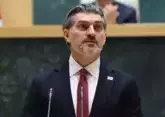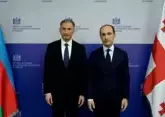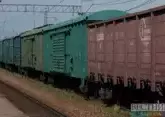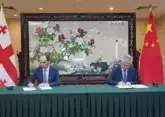Afghanistan, Turkmenistan, Azerbaijan, Georgia and Turkey signed a historic international trade and transport corridor deal on the sidelines of the 7th Regional Economic Cooperation Conference on Afghanistan (RECCA-VII) in Ashgabad. The Lapis Lazuli corridor will connect these five countries, complementing other transport routes created in recent decades to transport goods from Asia to Europe and back. Its railways and motorways will run from Turqundi in Afghanistan’s western Herat province to Ashgabat, then they will continue to Turkmenbashi in Turkmenistan and after passing the Caspian Sea will link Baku to Tbilisi and ports of Batumi and Poti, then will run to Ankara and Istanbul. Former Georgian Finance Minister David Iakobidze told Vestnik Kavkaza about the significance of the new multifunctional transport corridor.
- You were at the origin of the development of projects for Georgia's participation in the implementation of the Silk Road Initiative and TRACECA. How long ago did it start?
- The Lapis Lazuli transport project is being carried out within the framework of the Eurasian project TRACECA. It has been developed for several decades, being of great benefit to all the states participating in it. Georgian experts (including me) have taken an active part in the discussion of various TRACECA projects since the 1990s, and the first talks about this have started in 1989, even in the USSR. And even back then, the Tbilisi-Baku-Ashgabat transport line attracted the attention of specialists. Now, apparently, all the conditions have been created for using this transport corridor, it is already impossible to meet growing needs without a whole network of similar corridors linking Central Asia, the Caspian basin with Turkey and Europe.
- What is the peculiarity of the Lapis Lazuli project, what distinguishes it from other projects of the Great Silk Road?
- It's about cargoes from Afghanistan, but not only them. The delivery of goods to Afghanistan is an important issue, because this Central Asian country is at the center of global interest. Afghanistan is closely linked to neighboring Turkmenistan. In the 1990s, Georgian President Eduard Shevardnadze appointed an ambassador to Afghanistan and Turkmenistan, farsightedly bringing together diplomatic missions in two states. Then we together analyzed all the issues, considering the fact that Afghanistan can enter the European markets through the Turkmenistan - Azerbaijan - Georgia - Turkey line. The way through Iran is associated with a number of obstacles, including geographical and technical ones. The Caspian ports of Turkmenbashi and Baku will play a key role in it. But goods can also move towards Astrakhan. No one has ever denied this prospect from the very beginning, since this corridor does not exclude the Russian direction, taking into account transport and geographical possibilities of the Caspian Sea.
- You mentioned the movement of goods in the opposite direction from Europe, Turkey and Azerbaijan - to Turkmenistan and Afghanistan ...
- Speaking about transport corridors within the framework of TRACECA and the Great Silk Road, one often remembers only cargo flows from the East to the West. However, this corridor can also be of no less significance in terms of export of Georgian and Azerbaijani goods to the Central Asian rapidly growing markets, including Afghanistan. Lapis Lazuli will be especially useful for road transportation. In this respect, Georgia and Azerbaijan have still unclaimed potential. Therefore, it would be wrong to say that Lapis Lazuli will allegedly compete with such projects as the Baku-Tbilisi-Kars railway. On the contrary, they will successfully complement each other. Shevardnadze was well aware of how useful all this could be for Georgia. Therefore, he took such an active part in the implementation of such projects. That is, those projects that were developed with the participation of Eduard Shevardnadze and Heydar Aliyev are yielding their first results. Lapis Lazuli is one of the manifestations of the old strategy.
- What countries can join the Lapis Lazuli project?
- I have already said that it complements other TRACECA projects. Nomenclature of goods is so great, and the volume is so high and rapidly growing that Kazakhstan, Tajikistan, Kyrgyzstan and Uzbekistan may join it, but this is a matter for the future, albeit not too distant future, since it will not be possible to cover everything at once. However, we are actively working on this. From the trade nomenclature I can name Uzbek cotton, Tajik aluminum - the region has huge potential, and the Azerbaijani-Georgian "bridge" can play a key role in bringing these resources to European markets. Georgia, as well as Azerbaijan, has much to offer for transportation along the Eurasian "bridge". "For example, Georgian fruits and tea will be delivered not only to Central Asian countries, but even to the Altai - which may be the shortest and most profitable route. Fortunately, the Lapis Lazuli project already has technical and financial capacity and the Ashgabat conference clearly demonstrated it.
- Are there any risks associated with active traffic on this and other routes?
- There are always such risks. First of all, they are connected with drug trafficking, but the participating states are fully capable to minimize them, combining their efforts. On the other hand, not all states can participate in such projects today. For example, Armenia "excluded itself" from it for certain reasons, although TRACECA and its components are potentially beneficial for all countries in the region, including Armenia. But Georgia and Azerbaijan have become a "bridge" for the delivery of goods to the seas and oceans, that is, the main global communications. As for the "competition" of various projects within TRACECA, then in the context of using the Baku-Tbilisi-Kars railway, which is very useful in all respects, the Lapis Lazuli project can load the main Georgian port of Poti. Many feared for its fate, but these fears were in vain, because they plan to transport goods from west to east as well. Much depends on coordination of transport opportunities and competent logistics. It is necessary to develop and unify an adequate regulatory framework, in particular, uniform transport codes. In this case, the Lapis Lazuli project will be even more useful.










